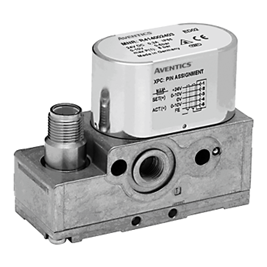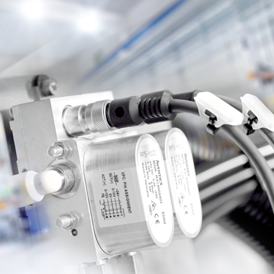Pulsed Air-Piloted Valves or Direct-Acting? When OEMs Only Go With What They Know, They May Be Missing Out
By Tom Voth, product marketing manager: pneumatic machine safety and electronic proportional valves, Emerson
OEMs are always seeking solutions that reduce machine complexities and minimize operator intervention, and proportional valves are one of many important technologies involved in achieving these design goals. Though several proportional valve designs exist, pulsed air-piloted and direct-acting are the most commonly used. It’s here within this mid-range of valve capabilities that OEMs have an opportunity to optimize performance by pairing the right valve with the right application.
Where some OEMs go with what they know and use pulsed air-piloted valves for both static and dynamic applications, others have learned that better performance and reliability can be achieved by using direct-acting valves for dynamic applications with more demanding requirements.
For both types of applications, it’s not so much about which valve can do the work. Instead, it’s about the benefits that can be gained when the right valve is selected. To distinguish which types of applications are best suited for pulsed air-piloted valves and which would benefit more from direct-acting, it helps to understand the basic mechanics of each valve type and the conditions under which each performs at its best.
Pulsed air-piloted valves
Pulsed air-piloted valves load and unload air pressure into a pilot control chamber to move a diaphragm that acts on the piston to open and close the valve. This opening and closing action relies on the pilot valve cycle rate, which can vary from valve-to-valve and in some dynamic application may lack sufficient resolution resulting in unacceptable stepped pressure adjustments or pressure swings. Because of these pressure swings and the minimal amount of adjustment available to correct for them, air-piloted valves typically work best in static applications where the pressure setpoint remains fixed for the majority of the operation. An example of a static application that is ideal for air-piloted valves is maintaining head pressure on a liquid filling machine.
One key distinction between pulsed air-piloted valves and direct-acting valves is the number of components involved in their construction. An air-piloted valve comprises many components, including a rolling diaphragm and pulsed solenoid pilot valves, that move the piston to regulate pressure. Compared to direct-acting valve designs with fewer components, the greater number of parts in air-piloted valves adds both complexity and performance variability from one valve to another. These are important considerations that should be weighed when designing for applications that require precision and repeatability.
In addition, the many components of an air-piloted valve can wear over time, particularly when used in applications with rapid cycle rates and constantly changing setpoints. Components may also be more susceptible to compressed air quality issues. For all these reasons, air-piloted valves should be reserved for applications with low cycle rates and static setpoints to ensure best performance.
Direct-acting valves
As their name implies, direct-acting valves act directly on a piston or spool to adjust the valve’s open or close position based on varying voltage across the coil. This direct action offers a number of advantages that cannot be accomplished by using an air-piloted valve in a dynamic environment, including faster response times and finer response resolution. These behaviors are why direct-acting valves perform best in dynamic operations, such as material testing or motion control where the valve must repeat a specific pressure profile for successful operation.
To illustrate a key advantage of direct-acting valves, consider an operation in which a cycle rate may suddenly increase or decrease. The abrupt shift in pressure can generate a shock that transfers a small amount of movement to the piston. When this piston shock occurs, the simpler, more robust design of the direct-acting valve can deliver a faster and more controlled response to the movement than an air-piloted valve. This swift and precise control is critical for applications like web/roll tensioning, robotic deburring and polishing, where pressure swings can lead to material tears, tool breaks or damaged parts if not properly controlled.

Another advantage of the direct-acting valve is reducing the common problem of overshoot. Overshoot occurs when a valve moves past its setpoint and then must reverse back to its position, potentially overshooting again and correcting a second time. This scenario is common in systems that are programmed for short response times in which valve movement is happening at a rapid pace. While a direct-acting valve does not guarantee elimination of overshoot conditions, it can notably reduce the amount of time it takes the valve to settle out of these conditions by varying the current to the coil that directly controls the piston.
For dynamic proportional control, direct-acting valves offer clear performance advantages over air-piloted valves, including faster, more controlled responses to cycle rate and pressure changes.

Direct-acting proportional control valves offer a number of distinct advantages within dynamic applications, including faster response times and finer response resolution.
The right tool for the job
Air-piloted valves and direct-acting valves both play important and distinct roles in delivering proportional pressure control to a wide variety of applications. To enjoy the full benefits of both, some OEMs may need to step out of their comfort zones to explore less familiar designs like direct-acting valves and learn more about where these valves can offer better control.
The best way to learn is by reaching out to a reputable proportional valve manufacturer. Manufacturers have expert knowledge of their own product lines, and they can work with you to select the best proportional technology for your particular application. They can also supply you with a broad range of sizes, models and features to explore and test, and they can answer questions along the way. Air-piloted valves are what the industry knows best, and they are certainly a great solution for static pressure control and low cycle rate applications. But for those who want greater control over their equipment designs, understanding both air-piloted and direct-acting valve technologies and applying them appropriately will result in better outcomes like simpler machine designs, fewer operator interventions and reduced field service calls.
